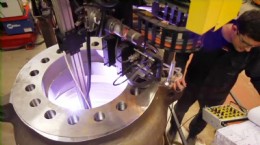ARC Energy
Increasing the life expectancy of valves & actuators

Weld overlay cladding

In such applications, what techniques are available to enhance the life of new plant or refurbish worn or corroded equipment; and what are the cost benefits compared to expensive base materials and/or replacement parts?
Engineers have a number of options when considering corrosion protection. However, the final solution will depend in part on an evaluation of factors such as the presence of chemically aggressive compounds; the level of suspended solids, if any, in the product; the installation deadline; and budget restraints. Where budget is not a constraint, engineers can simply specify valves and actuators in corrosion or wear resistant alloys known to withstand the specific service conditions. However, this is rarely the case and other, more cost-effective options must be sought.
Where standard, carbon steel valves and actuators are used, weld overlay cladding is certainly the most versatile option, providing the assurance of a heavyduty metallurgically-bonded protective layer that will not be undermined or dislodged in service.
After first identifying the areas within the equipment that need to be protected, and the properties of the medium from which protection is required, engineers can choose from a number of welding processes and a wide range of cladding alloys. The final choice will depend on the size and geometry of the components to be clad and the alloy best suited to combat the surface degradation, whether from corrosion or erosion.
This is also true when weld overlay cladding is used to protect oilfield valves from corrosion. As oil and gas wells are sunk deeper and produce hotter and more aggressive ‘cocktails’ of corrosive media, equipment manufacturers are forced to specify highly alloyed materials for valves and associated components to overcome the inevitable corrosion problems. Carbon and low alloy steels through to stainless steels are all capable of being overlay clad to provide corrosion resistance in specified areas, or indeed over all surfaces in the case of the carbon and low alloy varieties, to provide total resistance.
For some applications limited corrosion may be tolerated on the body of a component manufactured from low alloy or stainless steel, provided complete integrity is assured in sealing areas. It is here that a more corrosion-resistant material can be applied using weld overlay cladding. Similarly, where total corrosion protection is required, it makes economic sense to manufacture the component in a cheaper alloy and overlay clad with a corrosion-resistant alloy, rather than manufacture the whole component in a more expensive, highly alloyed material.
In a typical example of the application of weld overlay cladding, Arc Energy Resources applied a coating of corrosion resistant alloy to protect a brand new oilfield valve and refurbish an old one. As the dual valve bodies were handling aggressive oils or gases that corrode the surface of the steel, the specification for both included a corrosion and wear resistant weld overlay cladding to their inside diameters.
Arc Energy applied a weld overlay cladding of Inconel 625 to all three bores of a new 51/8" valve. The main bore of a 5" valve, which had been eaten away by sour gas or oil, was first machined to remove the corrosion, and then coated by Arc Energy before the bore was machine-finished to its original specification.
The choice of coating chemistry is vast; and the processes available extend from the lowly manual metal arc to multi head hot wire TIG to laser and beyond! Many previously ‘difficult to weld’ materials are now commonly welded with consistent success. Arc Energy has developed an extensive library of weld procedures and welder qualifications, certified in accordance with international standards including ASME, API, ISO, DNV, Norsok, MIL and many others. A comprehensive range of base metal/overlay combinations are covered, including carbon and low alloy steels, martensitic, austenitic, 22Cr duplex and 25Cr super duplex stainless steels, nickel and copper based alloys. Its weld overlay cladding has been widely implemented in a wide variety of markets.
In fact, the development of the cladding process is such that acceptance standards for the cladding material are identical to those for the base material and can therefore be applied specifically to the areas under attack, eliminating the need to produce a whole component or item of plant from an expensive corrosion resistant material.
However, the overwhelming advantage is its versatility. Whatever the shape or size of the equipment or component there is a process that can be applied and an alloy to counteract the different levels of corrosive attack. Weld overlay cladding is a proven and recognised cost saving technology that is already well established in the oil & gas industry and engineers in these extreme environments are sharing the significant benefits, both practical and financial, of increased life expectancy.
And finally a caveat: it is important to use a cladding provider that holds ISO 3834-2 and employs the services of a proven European Welding Engineer.
ARC Energy Resources Limited
Tel: 01453 823523
Website: www.arcenergy.co.uk
Published: 31st August 2011
Rachel Wormald, Managing Director at YPS Valves Ltd and Elizabeth Waterman, ...
Are you looking for industry-leading, brand independent valve and actuator ...
As can be seen from the photograph, clearly the resident birds at Bartlett ...
Howco Group has unveiled its latest £1million investment, with the ...
In 2024, Allvalves is poised for an exciting year of growth and expansion, ...
GMM Pfaudler Engineered Plastics & Gaskets are delighted to bring the ...
In the ever-evolving valve industry, GMM Pfaudler stands out for its ...
SAMSON Controls Ltd – part of the SAMSON group - a renowned leader in ...










